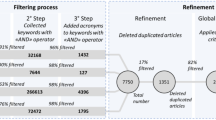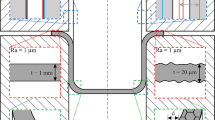Abstract
Optimization method and numerical simulation technology have been applied in sheet metal forming process to improve design quality and shorten design cycle. However, deterministic optimization may lead to unreliable and non-robust design due to not considering the fluctuation of design variables, environments and operation conditions, etc. In addition to that, iterations in optimization process may cause numerous simulation time or expensive experiment cost. A CAE-based six sigma robust design procedure is developed in this paper with the purpose to eliminate effect of uncertainties in design so as to improve quality. By applying Design of Experiment, Analysis of Variance, and Dual Response Surface Model, this procedure integrates Design for Six Sigma (DFSS), reliability optimization and robust design together to perform optimization. Deep-drawing processes of square cup (NUMISHEET’93) and cylindrical cup (NUMISHEET’2002) are studied as examples, in which thickness variation is taken as the optimization objective, and wrinkle and rupture criteria are taken as constraints. The results show that this design optimization method not only improves significantly the reliability and robustness of the forming quality, but also increases design efficiency with approximate model.
Similar content being viewed by others
Reference
Nakamura Y, Ohata T, Katayama T, Nakamachi E (1998) Optimum die design for sheet metal forming process by using finite element and discretized optimization methods. Simulation of materials processing: theory, methods and applications, Rotterdam, pp 787–792
Barlet O, Naceur H, Batoz JL, Knopf-Lenoir C (1998) Shape optimum design of blank contours using a simplified inverse approach. Simulation and materials processing: theory, methods and applications, Rotterdam, pp 801–806
Huh H, Kim SH (2001) Optimum process design in sheet metal forming with finite element analysis. J Eng Mater Technol 123(4):476–481
Choi KK, Kim NH (2002) Design optimization of springback in a deepdrawing process. AIAA J 40(1):147–153
Browne MT, Hillery MT (2003) Optimizing the variables when deep-drawing C.R.1 cups. J Mater Process Technol 136(1–3):64–71
Gasper G, Pepelnjak T, Kuzman K (2002) Optimization of sheet metal forming processes by the use of numerical simulations. J Mater Process Technol (130–131):54–59
Jaisingh A, Narasimhan K, Date PP, Maiti SK, Singh UP (2004) Sensitivity analysis of a deep drawing process for miniaturized products. J Mater Process Technol 147(3):321–327
Kleiber M, Rojek J, Stocki R (2002) Reliability assessment for sheet metal forming operations. Comput Methods Appl Mech Eng 191(39–40):4511–4532
Taguchi G, Chowdhury S, Taguchi S (2000) Robust engineering. McGraw-Hill, New York
Su J, Renaud JE (1997) Automatic differentiation in robust optimization. AIAA J 35(6):1072–1079
Arvidsson M, Gremyr I, Johansson P (2003) Use and knowledge of robust design methodology: a survey of Swedish industry. J Eng Des 14(2):129–143
Sandgren E, Cameron TM (2002) Robust design optimization of structures through consideration of variation. Comput Struct 80(20–21):1605–1613
Breyfogle FW (2003) Implementing six sigma: smarter solutions using statistical methods. John Wiley & Sons, New Jersey
Klefsjo B, Wiklund H, Edgeman RL (2001) Six sigma seen as a methodology for total quality management. Meas Bus Excell 5(1):31–35
Banuelas R, Antony J (2003) Going from six sigma to design for six sigma: an exploratory study using analytic hierarchy process. TQM Mag 15(5):334–344
Vining GG, Myers RH (1990) Combining Taguchi and response surface philosophies: a dual response approach. J Qual Technol 22(1):38–44
Lin DKJ, Tu WZ (1995) Dual response surface optimization. J Qual Technol 27(1):34–39
Danckert J (1995) Experiment investigation of a square-cup deep-drawing process. J Mater Process Technol 50(1–4):375–384
Acknowledgement
This research is funded by National Natural Science Foundation of China (item number: 50475020) and this support is gratefully acknowledged.
Author information
Authors and Affiliations
Corresponding author
Rights and permissions
About this article
Cite this article
Li, Y.Q., Cui, Z.S., Ruan, X.Y. et al. CAE-Based six sigma robust optimization for deep- drawing process of sheet metal. Int J Adv Manuf Technol 30, 631–637 (2006). https://doi.org/10.1007/s00170-005-0121-y
Received:
Accepted:
Published:
Issue Date:
DOI: https://doi.org/10.1007/s00170-005-0121-y




